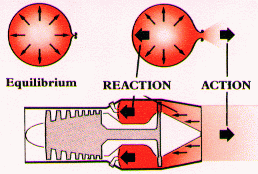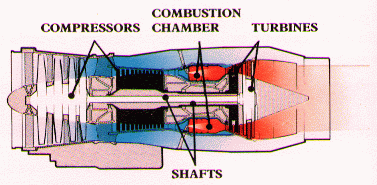
The jet engine (or gas turbine) is an internal combustion engine which produces power by the controlled burning of fuel. In both the gas turbine and the car engine, air is compressed, fuel is added and the mixture is ignited. The resulted hot gas expands rapidly and is used to produce the power.
Unlike the car engine, in the a gas turbine the burning is continuous and the expanding as is ejected from the engine as an action. Using the principle expounded by Sir Isaac Newton in the 17th century (to every action there is an equal and opposite reaction) this action creates a reaction of equivalent force.

Layout of the gas turbine
The gas turbine engine is basically a machine designed to accelerate a stream of gas which is used to produce the reactive thrust necessary to propel the aircraft.
The gas turbine has three main components: the compressor, combustion chamber, and turbine.

The compressor
Situated at the front of the engine, the compressor draws air in, pressurizes it, then delivers it into the combustion chamber.
The combustion chamber
This is an annular tube, or ring or tubes, made from heat-resistant steel, in which the fuel and air are mixed and ignited. It is designed to achieve the most efficient combustion of the mixture so that the maximum possible heat energy is extracted from the fuel to give the greatest rise in temperature and hence expansion of gases.
The air from the compressor, at high pressures, passes into the combustion chamber where it is mixed with the vaporized fuel sprayed from burners located in the head of the chamber. The mixture is ignited, during the engine starting cycle, by ignited plugs located in the compressor. Once ignition has taken place, the ignitors are isolated and combustion is continuous.
The turbine
The turbine consists of one or more stages of alternate stationary rotating aerofoil-section blades. The rotating blades are carried on discs, in a similar way to the compressor, and the discs are connected by a shaft to the compressor rotating assembly. The stationary bales, known as nozzle guide varies, are housed in the turbine casing. The function of the turbine is to absorb sufficient energy from the hot expanding gases leaving the combustor to keep the compressor rotating at its most efficient speed.
Afterburning
Afterburing is a method of increasing the engine thrust for short periods to improve the aircraft take-off, climb and, combat performance. Unlike a piston engine, the fuel in a fast turbine burns in an excess of air, so there is still sufficient oxygen present to support further combustion. This makes it possible to inject and burn additional fuel in the jet pipe, downstream of the turbine, to increase the engine thrust.
Reverse Thrust
Thrust reversal is a method of mechanically deflecting the exhaust stream of a gas turbine forward extremely, to act as a braking force when the aircraft land. The system is most efficient when used at the relatively high speeds immediately after touch-down.
Reverse thrust is particularly useful in adverse weather conditions, and can be used to augment, or instead of, the aircraft's wheel-braking system.
These graphs show the changes in pressure, velocity and temperature of the gas as it passes through the various stages of the engine.
